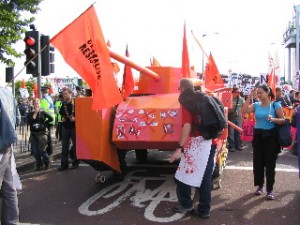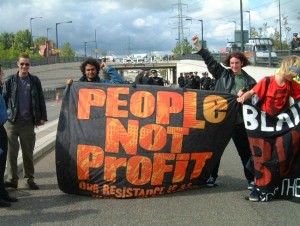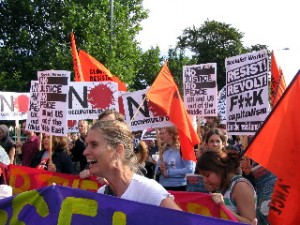STOP THE ARMS FAiR : DSEi 2003
 Compare the actions of the anti-DSEi campaign with that of two years ago. This time round it was lively, colourful, bigger, more diverse and more effective. The activists on the streets had the wishes of the majority of people with them and the impact was far bigger.
Compare the actions of the anti-DSEi campaign with that of two years ago. This time round it was lively, colourful, bigger, more diverse and more effective. The activists on the streets had the wishes of the majority of people with them and the impact was far bigger.
Having heard reports of various actions leading up to the launch of the DSEi (blockading the arriving exhibits, an occupation of the government’s Export Credit Guarantee Department and protests at the offices of various exhibiting corporations) I was eagerly anticipating the first big public demonstration, saturday’s ‘Unity March’ in central London.
As we prepared to set off, it looked like we had a reasonable turn out - couple of hundred give or take. But lots more people suddenly arrived just at the last minute. Isn’t it great when that happens. And the numbers just seemed to keep growing as the march progressed and we were joined by the green-clad Sheffield Samba Band. Protesters must have numbered about a thousand by the end of the march. For about an hour we walked, following Campaign Against the Arms Trade’s enormous banner. Various orange flags proclaiming “Globalise Resistance” intermingled with green placards carried by environmental groups, red and black flags of the anarchist contigent and a myriad other factions united in their opposition to the macabre spectacle soon to begin inside the glitzy chambers of the ExCel Centre.
 Over the next two days various meetings, talks and workshops including non-violent direct action training and legal briefings took place at the Disarm DSEi convergence centre. Activists went about their business undeterred by the intimidation tactics of a couple of white vans and their crew.
Over the next two days various meetings, talks and workshops including non-violent direct action training and legal briefings took place at the Disarm DSEi convergence centre. Activists went about their business undeterred by the intimidation tactics of a couple of white vans and their crew.
On Tuesday Morning Campaign Against the Arms Trade and Globalise Resistance led an assortment of peaceful protesters (including green groups, anarchists, samba bands, Stop The War Coalition, Revolution with their bright red flags… and many more) on a march to the ExCel centre. Colourful costumes, props, banners, placards and flags were plentiful. But most spectacular was GR’s gigantic camoflage pink and orange battle tank complete with crossed out corporate logos and a corked gun barrel.
After a round of speeches, we were asked to disperse by the police. Having dispersed, many of the protesters met up later on at a nearby roundabout and were joined by a new crowd (including a large pink&silver bloc) for the “Fluffy DSEi” mass action. That afternoon, the area around the ExCel Centre was the scene of fluffy road blockades and frivolous games of cat & mouse with the police. The around 2000 officers drafted in for the Disarm DSEi protests really swelled the numbers. Protesters would not have been able to block nearly so many roads had it not been thanks to the ladies and gentlemen in blue.
 Wednesday got off to a late start and with smaller numbers but the blockaders were no less up for it. And somebody apparently took it upon themselves to join two trains together with a cyclist’s D-lock thus causing major headaches for delegates on their way to the exhibition. The day was to culminate in a street party organised by Reclaim The Streets. This got off to a really good start, with a colourful sound system and many hundreds of people. When the police eventually managed to get a hold on the situation, they penned in around 200 of us and let us gradually disperse from a nearby park. Meanwhile, another succesful blockade was also being cordonned off by her majesty’s constabulary at Canning Town roundabout.
Wednesday got off to a late start and with smaller numbers but the blockaders were no less up for it. And somebody apparently took it upon themselves to join two trains together with a cyclist’s D-lock thus causing major headaches for delegates on their way to the exhibition. The day was to culminate in a street party organised by Reclaim The Streets. This got off to a really good start, with a colourful sound system and many hundreds of people. When the police eventually managed to get a hold on the situation, they penned in around 200 of us and let us gradually disperse from a nearby park. Meanwhile, another succesful blockade was also being cordonned off by her majesty’s constabulary at Canning Town roundabout.
The last action I attended was on Thursday evening. Encouraged to hear that somebody had again managed to stop the Docklands Light Railway trains around the ExCel Centre earlier in the day, I was eagerly awaiting the evening’s demonstration. And it turned out to be a large one. Several streets were reclaimed with the help of a mini-critical mass and a soundsystem on wheels. Free veggie food was on offer and at the height of the event hundreds of colourful protesters were present. The soundsystem and a samba band made for a great atmosphere. As the evening drew on, the protesters gradually were replaced by large numbers from a familiar uniformed gang, including one fellow with a penchant for taking large numbers of photographs, using a camera with a very bright flash.
Although I wasn’t present, I read on Indymedia (www.indymedia.org.uk) that Friday’s picnic for protesters who weren’t exhausted or incarcerated had gone smoothly if not entirely to plan. Gategrashed by you can guess who, the party was apparently saved by a variety of fun (and rather surreal) games that involved behaving very strangely in ways that thoroughly confused the uninvited guests.
So… what a week. I was a little disappointed by the numbers. I had hoped that thousands would be present on the Tuesday and Wednesday. This was not the case (although there were people from all over the UK and in smaller numbers all over Europe). However, it was a long and sustained campaign. Protest AND direct action took place throughout the week (and the period leading up to it). Significant disruption was caused to the arms fair, the cost of policing the event was over - £1 million and whilst obviously I wouldn’t even dream of condoning anything illegal, I do think the government may think twice about hosting this kind of event in future.
Also, the campaign had great media coverage, with front page articles and pictures on the Guardian, the Evening Standard and the (local) Newnham Recorder plus commentary and letters in various papers and a fair amount of TV and radio news coverage. In the period leading up to the DSEi, the arms fair made the front page of the New Statesman and (partly thanks to Globalise Resistance) the hugely witty Mark Steel penned a couple of collumns in the Independent. Thus through the use of the media, the Disarm DSEi campaign has surely made an impact on public opinion with regards to arms fairs and the arms trade.
Now it’s all over, it’s onwards and upwards to S27 and the European Social Forum.
Hugh Jones



















